Kitchen Project #21: Lemon Tart
Plus pistachio pastry and a head to head between custard, curd and posset!
Hello!
Welcome to another edition of Kitchen Projects, my recipe development journal. Part toolkit, part love letter, this is a space for pastry deep diving. Thank you for being here.
This week, we’re continuing on our tart journey and we’re going to be covering a real classic: lemon tart. And on the journey to the lemon tart, we’ll also be looking into some other citrus classics and what makes them tick - posset and curds, here we come.
A few weeks ago, I opened up Kitchen Projects+ (aka KP+!) - thank you SO much to everyone who has joined in. Having DMPC (deep and meaningful pastry conversations) about the future of Kitchen Projects and April cooking projects and ingredients inspo here has been fun.
It’s also magical watching conversations sprouting between members of the community on these threads! So much pastry knowledge comes from just good old chatting and in the sharing of past experiences, so if you haven’t chimed in yet then please check out those links above and join in the convo!
Here’s a little rundown on from this week on KP+:
On Wednesday, I shared a recipe for Vanilla, Ricotta and chocolate chip loaf cake. It’s a one bowl dream of a cake you can eat from dawn til dusk
In my exploration of lemon desserts, I whipped up a little passionfruit and lime posset. It’s buttery, sharp and absolutely beautiful… it also *just so* happens to be a perfect match for the pistachio pastry (bake it off as biccies!) in this week’s recipe. Recipe for that will hit your inboxes on Wednesday!
Alright, let’s get on with this week’s newsletter, shall we?
Love,
Nicola
---
Classic for a reason
There are certain desserts that stand the test of time and never go out of style. These are the kind of desserts that feature in every local pub kitchen as well as every Michelin star restaurant, albeit with a fancy twist.
You know the ones I mean. Off the top of my head, they are: creme brulee, custard tart, sticky toffee pudding, Eton mess, chocolate fondant, fruit crumble, treacle tart and… drum roll please… tart au citron aka baked lemon tart. If there was such a thing as a dessert hall of fame, these would all feature.
NB. If i’ve missed any true classics, LMK - chuck it down there in the comments, please!
And they’re there for a bloody good reason. These desserts, though they get tweaked and adjusted chef to chef, are absolute classics thanks to their flavour profiles, textures and joy-bringing abilities. But up until recently (I would say the last 5 years), I turned my nose up at baked lemon tart, thinking it was a boring option.
How wrong I was! Lemon tart is now one of my absolute dream desserts, though it has to be said that not all lemon tarts are created equal, some falling victim to soggy pastry or too-sweet fillings. A proper lemon tart should be ultra sharp, unctuous and smooth. And, of course, the pastry has to be properly crisp and buttery.
For today’s Kitchen Project, I’m presenting you with a classic tart with a bit of a twist - a beautiful pistachio pastry which we are throwing together in a food processor. We’re also going to be lining our tarts in the one way we *didn’t* cover last time.
Shall we do this?
Let’s talk citrus!
I’m not totally sure why but it took me a while to get in the zone with lemons (although I could ALWAYS eat an entire lemon drizzle in one sitting).
In order to create my dream lemon tart recipe I knew I needed to understand the whole range of lovely lemon-y things out there a bit better. I mean, what’s the deal with all the different creamy lemon desserts out there? What are the differences and what are the similarities? Is lemon doing more than just bringing that beautiful sour flavour? And if so, what are the cases where something bigger is going on underneath?
In my opinion, the big three players are as follows:
Lemon curd - eggs, sugar, butter and lemon juice are all heated together to 82c then left to cool
Lemon posset - this is made by heating double cream and sugar then stirring in lemon juice, passing then leaving to set in the fridge
Baked lemon tart - double cream, eggs, sugar and lemon juice are all whisked together, passed through a sieve then baked at a low temperature in the oven until just set
All of these boast amazing lemon profiles but have different underlying methods, structures and formulations. It got me thinking… are these interchangeable? What are the flavour profiles? And what is going on underneath all that lemon-y goodness? What do these players have in common and what makes them different?
Let’s go to the spreadsheet:
I made up a batch of each so I could taste the difference and qualities of each:
Posset has an incredibly clean - if sweet - taste. It is so softly set and disappears on the palate beautifully. For something made predominantly with double cream, it is remarkably light.
The curd is sharp and luxurious. It coats the mouth and tongue and is quite exciting to eat - ultra rich but acidic enough for you to keep going back. Although the zest has been left in, you hardly notice it and it doesn’t negatively affect the texture in my opinion. Ultra dangerous stuff.
The tart is a perfect harmony between the two. Definitely creamier than the curd but still with significant tang and unputdownably delicious.
So, shall we break it down?
The set
Lemon curd gets its setting quality from a mixture of whole eggs, yolks and butter itself. Although it’s important to cook the curd to egg-setting temperature (82c) to get the best texture possible, when the butter cools and solidifies, it does so in harmony with the other ingredients giving the famously thick and gorgeous lemon curd that we know and love.
Posset, on the other hand, is entirely set (softly, at that) from the reaction between acid and dairy, where the acid coagulates the proteins in the double cream. If you add lemon juice to heated milk, you’d get ricotta. So why doesn’t that happen with posset? Fat and sugar!
Although the acidified cream clumps up, the fat in the dairy gets in the way of these clumps being so… er… clumpy. The sugar keeps the texture smooth, again interfering with the network of proteins, hence the final smooth result.
Lemon tart is different. It has a higher proportion of eggs which are set as it is gently cooked. Although the tart is likely bolstered by the reaction between the acid and cream (lemon tart never seems to wobble *quite* as much as custard tart once it has set up after a few hours), the eggs really are the key ingredient here. Although judging the bake of a lemon tart still has its skill and reliance on wobbliness (though Heston suggests temping the custard, I cannot stand stabbing a lemon tart, even if its for *science*), it does feel lower risk than other gentle bakes like cheesecake or custard tart. An underbaked custard tart is a bit gross, whereas an underbaked lemon custard would still be beautiful, just less set.
Fat and mouthfeel
Posset has the highest percentage of % relative to the other ingredients, coming in at 31%. Thanks to the high proportion of double cream, posset literally melts on the palate as you eat it. Such a simple joy.
My lemon tart recipe and a classic curd recipe come in at a similar fat % although from different sources - the lemon tart is predominantly getting fat from the double cream (and a little from the whole eggs) whilst the lemon curd has butter to thank. Again, this helps explain the difference in texture and mouthfeel that you get from the two recipes.
The lemoniness
Since posset is balanced to have *just* enough acid to coagulate the dairy, the lemon % is relatively low. That being said, since posset only has three ingredients, it still shines brightly.
The curd, by far, is the zingiest! But also the sweetest - I think we can thank the zest that is left in for the additional twang of acidity. Again, the baked lemon tart seems to land firmly in the middle which is good.
The most famous baked lemon tart recipe has got to be from Heston, which I believe has its roots from the Roux brothers original recipe. Both of these seem to be the most widely circulated ones I’ve seen and most recipes (including the one I’m sharing today) can be traced back to here.
Although Heston’s lemon custard is divine, I personally find that it is missing a sharpness. So I decided to change things up a bit to see if I could add some piquancy, lowering the relative ingredients to put the lemon flavour front and centre. Whilst I was worried this might affect the set, there were no issues and I got the extra lemon bang for my buck!
This talk of zinginess brings us very nicely onto the subject of zest. Let’s do it
The deal with zest
So, one thing to think about when you’re approaching a lemon recipe is whether or not to keep the zest in. The zest adds a bunch of flavour and real tartness from the oils hiding in the skin. Almost all recipes will have you use the zest in at least one stage. But it’s whether you sieve it out or not that seems to be the point of difference.
I personally love the epic smoothness that comes from a zestless baked lemon tart. In most lemon tart recipes, the zest is warmed gently with the whole mixture before being passed through a fine sieve, the zest relegated to the bin. I wondered whether you were really getting the most out of your zest for this method.
Although warming the mix gently would release *some* of the lemon oils in the zest, the best way to fully release this flavour is with HEAT!
I have to admit now that in my first attempt to get the zingyness up, I heated double cream, lemon juice and zest in a pan until simmering and - unsurprisingly - it turned into ricotta. There was just way too much acid in there and it split. Oops. Great for spreading on toast. Not so great for baked lemon tart.
On my next attempt, I heated the double cream, half the sugar and thickly cut lemon peels together. The result? No splitting and instead a lovely lemon infused flavour. By adding some proper heat I was able to get the oils to release from the zest in a way that I hadn’t managed in the original method, bringing the lemon flavours up to 11.
Whole eggs vs yolks
Unlike custard tart, lemon tart is usually made with whole eggs. That’s great news for those who already have WAY too many whites in their freezer (hands up?)
The famous Heston recipe uses 9 whole eggs + a single egg yolk. Although there may be some benefit in the additional fat, emulsifying quality and - of course - colour, to me it isn’t worth having that extra white leftover and the improvement to the final quality of the custard is reasonably negligible.
Baking lemon curd
Although the texture of lemon curd is thick enough to sit in a shell on its own very happily, you can also take this one step further and bake it. To show you this versatility, I filled a tart case with lemon curd and baked it at 160c for 20 mins to firm it up.
This stabilises and thickens it and gives it an additional unctuous texture. Although it doesn’t look as perfect as the cream based baked lemon tart, it is much less fussy. You can bake it at much higher temps without fear of curdling and you don’t need to watch it for the wobble either.
Let’s talk pastry
So in the last newsletter we talked all about tarts. We covered two methods of lining tarts - the classic and the cut/stick technique. I casually mentioned a third method… and it would be remiss of me not to tell you all about it. It’s a really good one.
The third method is an ultra cowboy technique, which was pioneered by the fabulous Tarunima aka mylittlecaketin! This technique is the sort of thing that I wouldn’t dare doing at a trial in a fancy patisserie, even though I do it a lot at home, which is OUTRAGEOUS! And I’m now going to dedicate my life to being a better public advocate for this technique. Starting right now.
I’ve seen this method done a few ways. Sometimes the sweet pastry is made and frozen in a block before grating finely and then pressing into a tart case. This is a great way to speed up the whole lining process if you’ve got extra pastry hanging about in the freezer. However, if you’re making the pastry fresh then you do not need to go through the whole drama of freezing and grating it (also isn’t cleaning graters literally the most annoying thing ever? The only thing worse is cleaning sieves. Ugh. Tiny holes are the pits!). You can skip all of that and just press the pastry into the tart case whilst it’s all fresh from the mixer and soft soft soft!
It takes a bit of practice to get it nice and thin all the way around but this method works a treat. There’s absolutely no shrinking because - as we covered before - as long as you press the pastry well into the corners, there’s nowhere for it to go aka you can try to run, pastry… but you can’t hide! So, once again, you can ditch the baking beans.
Actually, the pressing method is so effective at removing or squashing air, you get brilliant results. And if you do it directly from the mixer, you only have to rest the dough one time - as opposed to 3 times! - compared to the other lining methods. Yes, it might give Raymond Blanc a bit of a shock, but it’s worth it.
The other benefit to the cowboy method is that you can be a bit wackier with your pastry formulations. I’m much more confident using an ultra buttery pastry - you know, the kind that gets ultra soft as soon as you look at it - with the pressing method. On that note, if you’re ever in trouble or tearing your hair out trying to line a tart case in the traditional ways, you can always fall back on the pressing method. The pressing method is your friend.
Food processor pastry
Based on the classic sweet paste recipe I shared before, this is a bit of a level-up. We’re making it in a food processor because it just makes so much sense! I’m pretty sure I’m not the only person that doesn’t have ground pistachios on hand, am I?
To make this pastry, we are going to start by grinding the pistachios in the food processor along with caster sugar. The caster sugar gives a bit of resistance and is coarse enough to speed up the grinding process slightly which stops the nuts from getting too oily, which can be an issue when you’re making your own ground nuts at home. As you grind the nuts the sugar also gets finer too which means you are left with ground nuts and an icing sugar type mix by the end of it.
Thanks to the cutting and slicing action of the food processor blade, you can also make a great short crumbly pastry as it’s much harder to overwork the dough. The whole pastry comes together in a few minutes which is great, too. That, plus the cowboy lining method, means you can start and finish the whole process (incl. lining) in under 20 mins!
Sealing
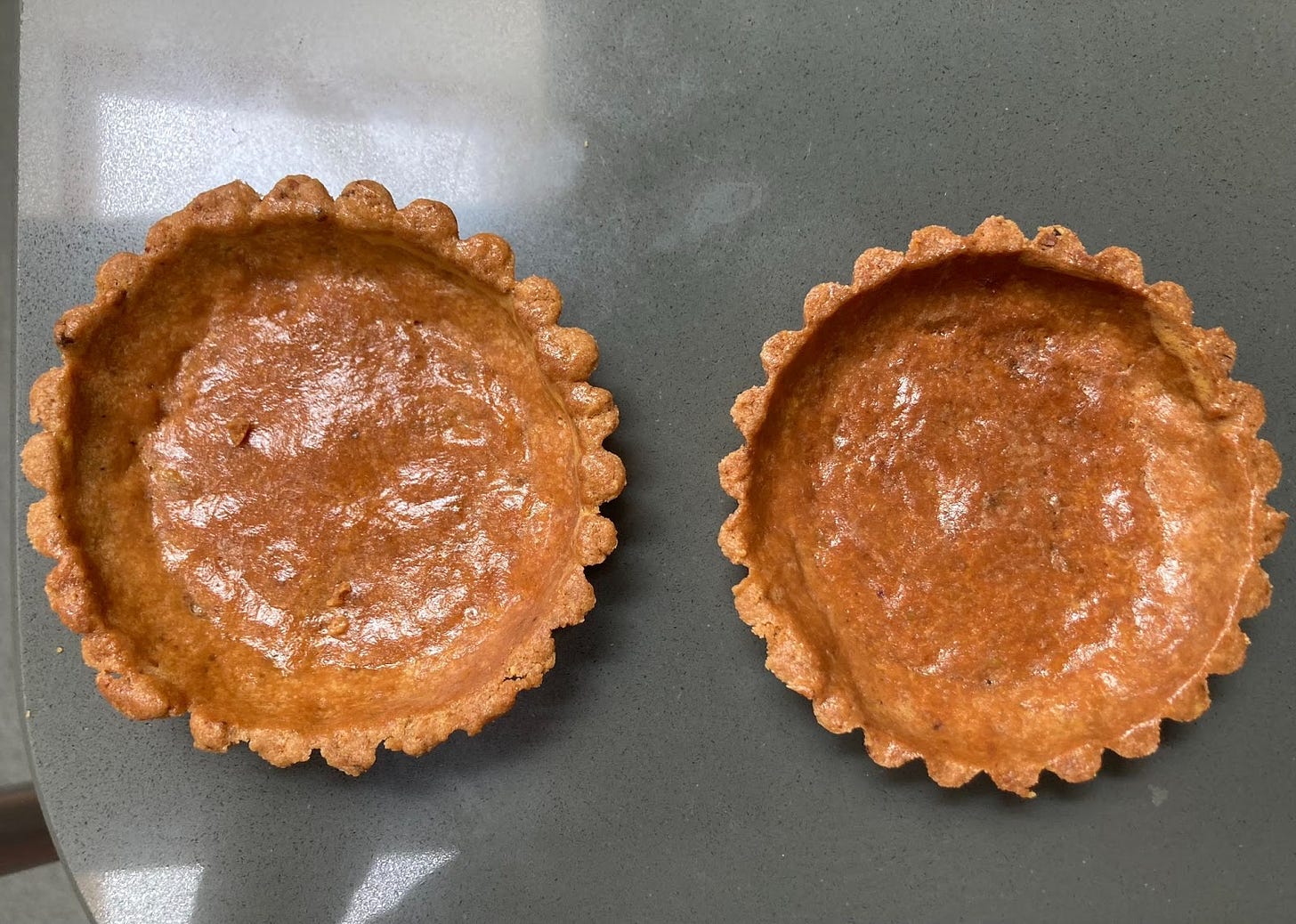
The last time we made tarts together, we filled them with frangipane which isn’t a leaky liquid. Today, we’re going to be filling with a lemon custard with the consistency of single cream. That means we need to seal our tart cases properly during the blind bake. This is actually a really simple process - we simply brush our tart cases with egg wash once they are baked and return to the oven to seal. I repeat this twice, just to be sure! You can plug any small holes with egg wash.
If for any reason after the initial blind bake you have a hole that looks like an egg wash fill won’t cut, use a little bit of raw pastry to plug up the hole, followed by a layer of egg wash. The key is to ensure no custard can run out - if this does happen, it’s not the end of the world but it is a bit annoying when your tart shell gets fused with the tin! If this DOES happen, then just grab a spoon.
Shall we get on with it?
Quick word on gelatine
Some lemon curd and posset recipes may utilise gelatine for additional setting quality. Now, is this necessary? In fancy patisseries, there is gelatine in pretty much everything! It just keeps things stable and looking their absolute best. At home, this isn’t really necessary for the most part. If a lemon curd recipe needs gelatine to set then it’s likely not well balanced in the first place. Gelatine, for curds and mousses, should be seen as a helping hand rather than a crutch.
Alright, let’s get on with the recipe!
Baked lemon tart with pistachio pastry
Pistachio and lemon sweet pastry
This makes more than you need but this pastry freezes extremely well and you can also bake these off as biscuits to enjoy with a KP+ recipe coming up next week
85g caster sugar
110g pistachios
90g butter
1 egg (55g)
175g plain four
3g salt
Zest of 1 lemon
Lemon custard - if you have leftover lemon custard, you can bake it in a rammekin!
If you are planning to bake this tart as one large, I was reminded by Pete (thank you Pete!) in the comments that it’s advisable to warm the whole lemon custard, once mixed, in a Bain Marie and heat until you reach around 55-60c. This stabilises your custard by par cooking and emulsifying it, which will prevent it from separating into two layers when baking. The two layers thing still tastes good but it’s worth doing this step if you’re planning to do a deeper tart
Zest of 4 lemons, thick pieces with a speed peeler
125g double cream
145g caster sugar
4 large eggs (around 210g)
125g lemon juice (around 4 lemons)
Egg wash
Optional: Creme Fraiche to serve
Optional: Pistachios, chopped, to decorate
Optional: Candied lemon peel to decorate
Pastry - method
Put the pistachio and caster sugar in the food processor and blitz until the pistachio is almost all gone - you still want a few bigger pieces for texture and it will continue to process down as we add more ingredients
Next add your cold butter and pulse until it is completely homogenous
Next add your egg and blitz until smooth
Add in flour and salt and pulse until it comes together in a ball
Pastry - lining
Whilst the pastry is still soft, divide into 40g balls and squash into your fluted tins, trying to achieve even thickness and make sure it is pressed properly into the corners
You can make a thick rim by pressing the pastry upward and making a little shelf using your forefinger and thumb. You can also just keep the edges ultra thin - both work well in this case and it’s entirely up to your design aesthetic!
Put cases into the fridge to rest for 30 mins. You can also put your cases into the freezer at this point if you need to and use later.
Pre-heat oven to 160c (fan)
Once rested - and if desired - trim pastry for a neater finish on the edge of the tin
Bake for 15 mins until lightly golden
Remove the tart cases from the oven and brush with a thin layer egg wash
Return to the oven for 5-10 minutes until golden
Brush with a thin layer egg wash once more
Return to the oven for another 5-10 mins until deeply golden and hard
You can use these cases immediately or they will keep in an airtight container for 5 days. Scroll up for a visual on this!
Lemon custard
Heat together lemon peels, double cream and half the sugar until simmering. Leave for 30 mins to infuse
Pre-heat the oven to 110c (fan) and put your tart cases in to warm up. This will reduce the overall cooking time needed as the cases are already warm!
Whisk together eggs and remaining sugar very well, followed by the infused double cream and lemon juice
If you are baking a deep tart, at this stage you should gently heat your mixture over a Bain Marie, whisking all the time until it reaches 55-60c before passing it. This will pre cook and emulsify the mixture, ensuring it stays stable in the oven and doesn’t split into two layers. This stage isn’t usually necessary for shallow tart cases but it is advisable for larger tarts
Pass through a fine sieve. I only had a tiny tea strainer - slow, but it works!
Use a spoon to remove any bubbles or foam from the top of the mixture. This can be a painstaking process but it’s important!
Pour the lemon custard into the tart shells. You can do this by pulling out the oven rack if that’s easier and you’re worried about spilling the custard
Bake until there is around 1 inch of good wobble in the centre of your custard. You don’t want to overbake it as this leads to potential cracks later down the line so just watch out for that. I start checking after 20 mins and then every 5-10 mins after that. It can take anywhere from 20-50 minutes, so just watch it like a hawk. My oven doesn’t cook evenly so I remove the tarts as and when they are ready, rather than waiting for them all to have the right wobble. Remember it’s better to underbake than overbake in this case! If you are baking a large tart, remember you have started the custard warm! So it may be faster to bake
Decorate with a spoon of creme fraiche, chopped pistachios and candied lemon peel for a lil extra extra. These are best enjoyed on the day you make them! Although they can last in the fridge for 2 days, it’s best not to decorate them until you’re ready to serve




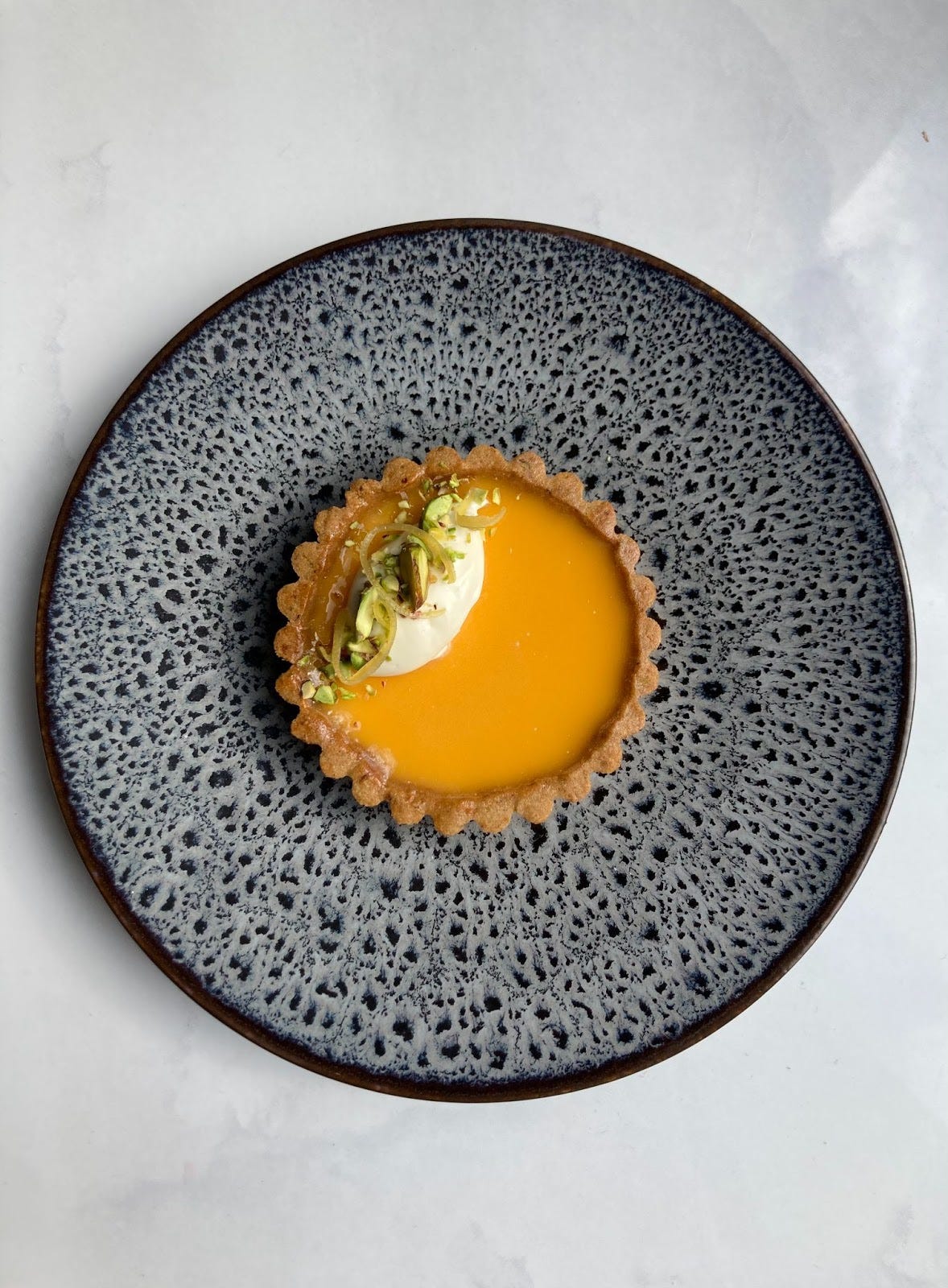
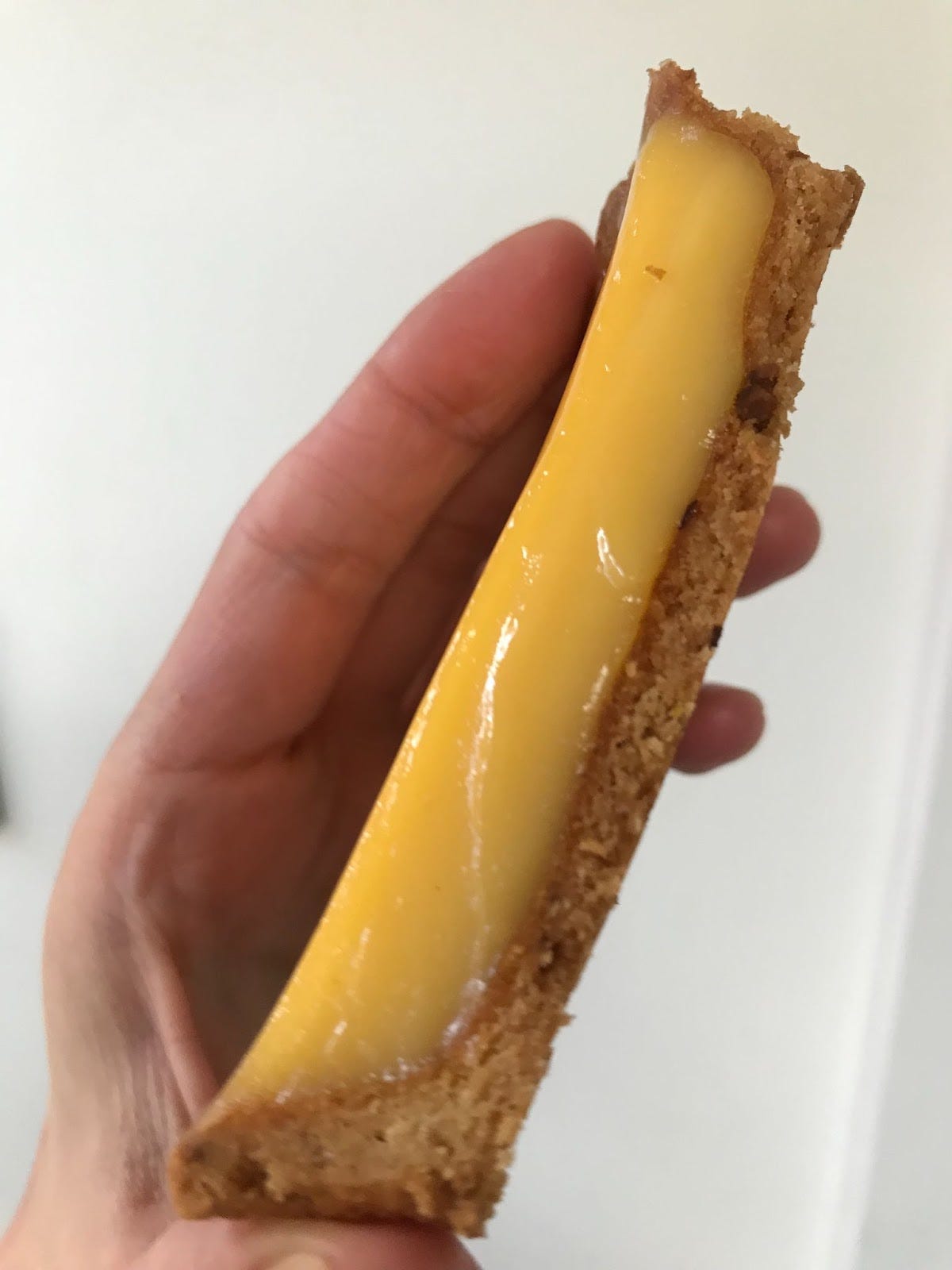
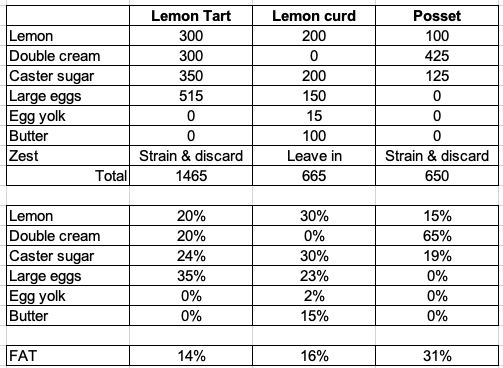
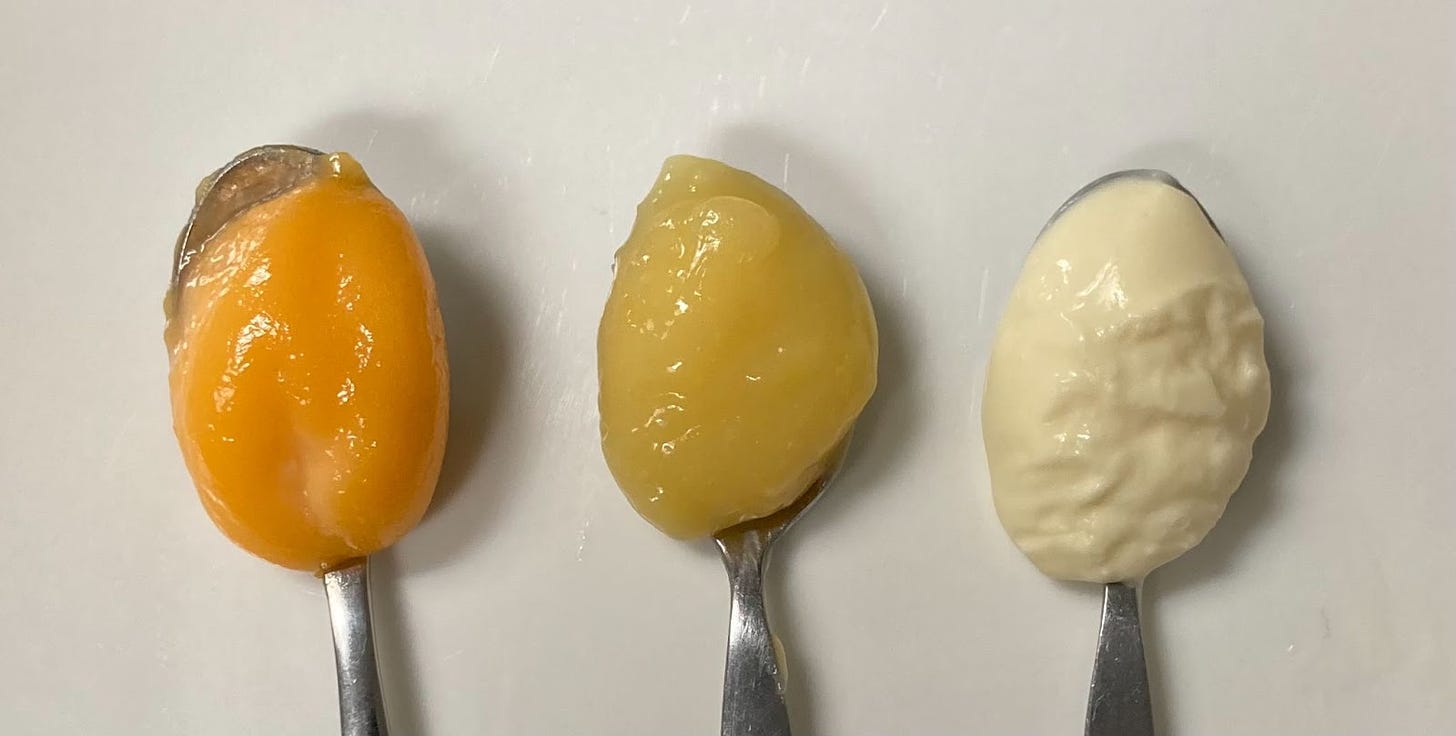
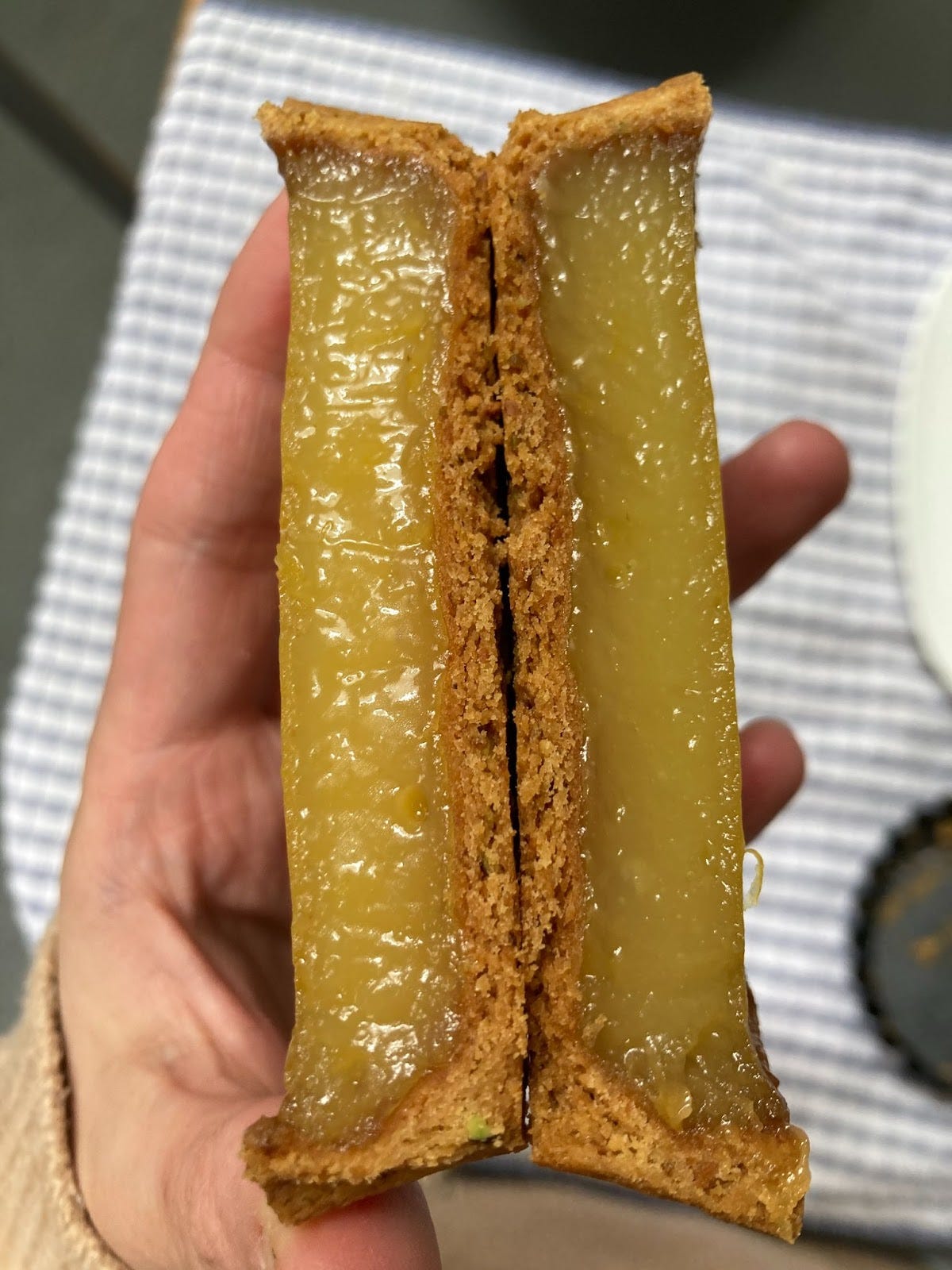
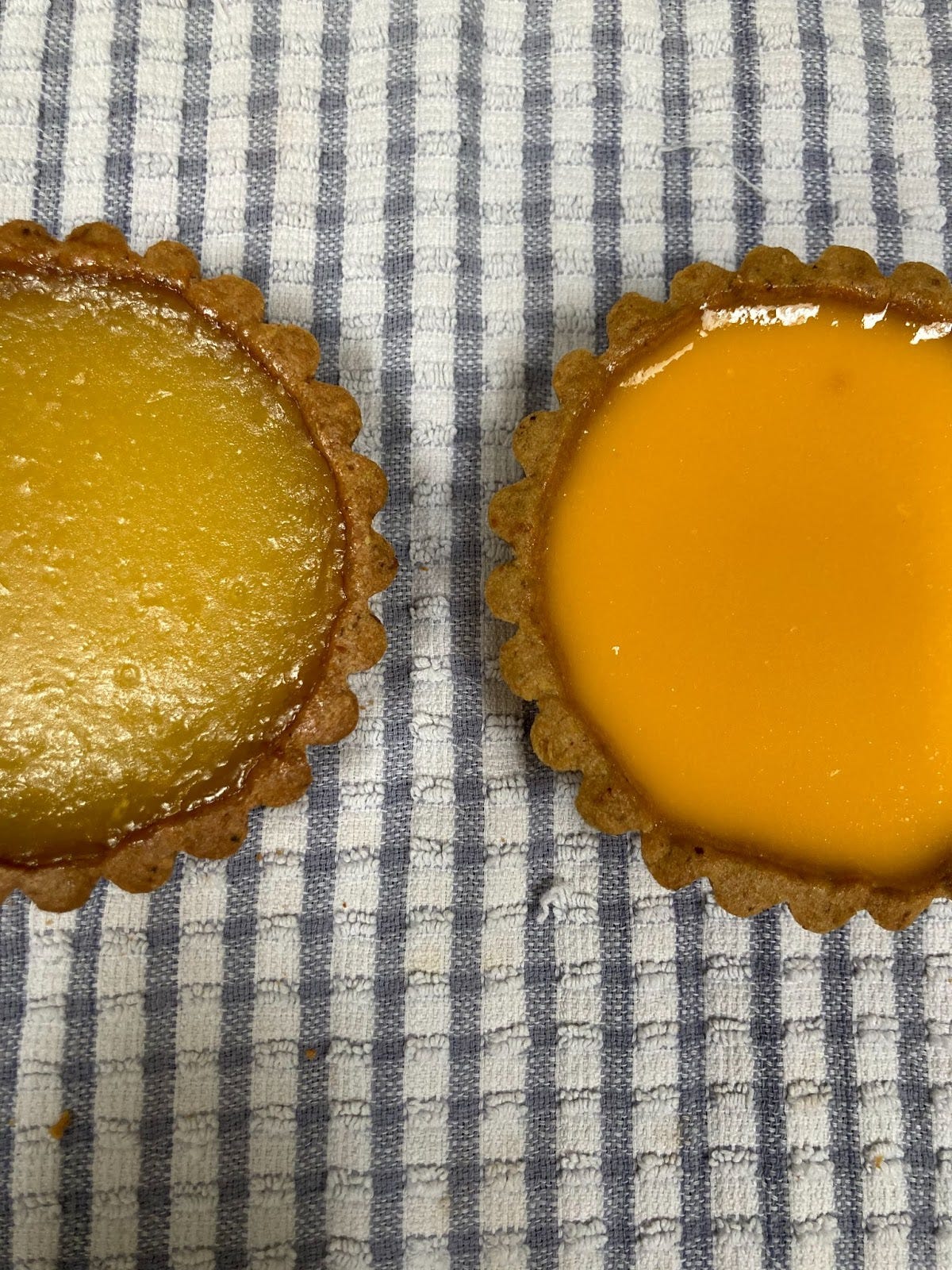


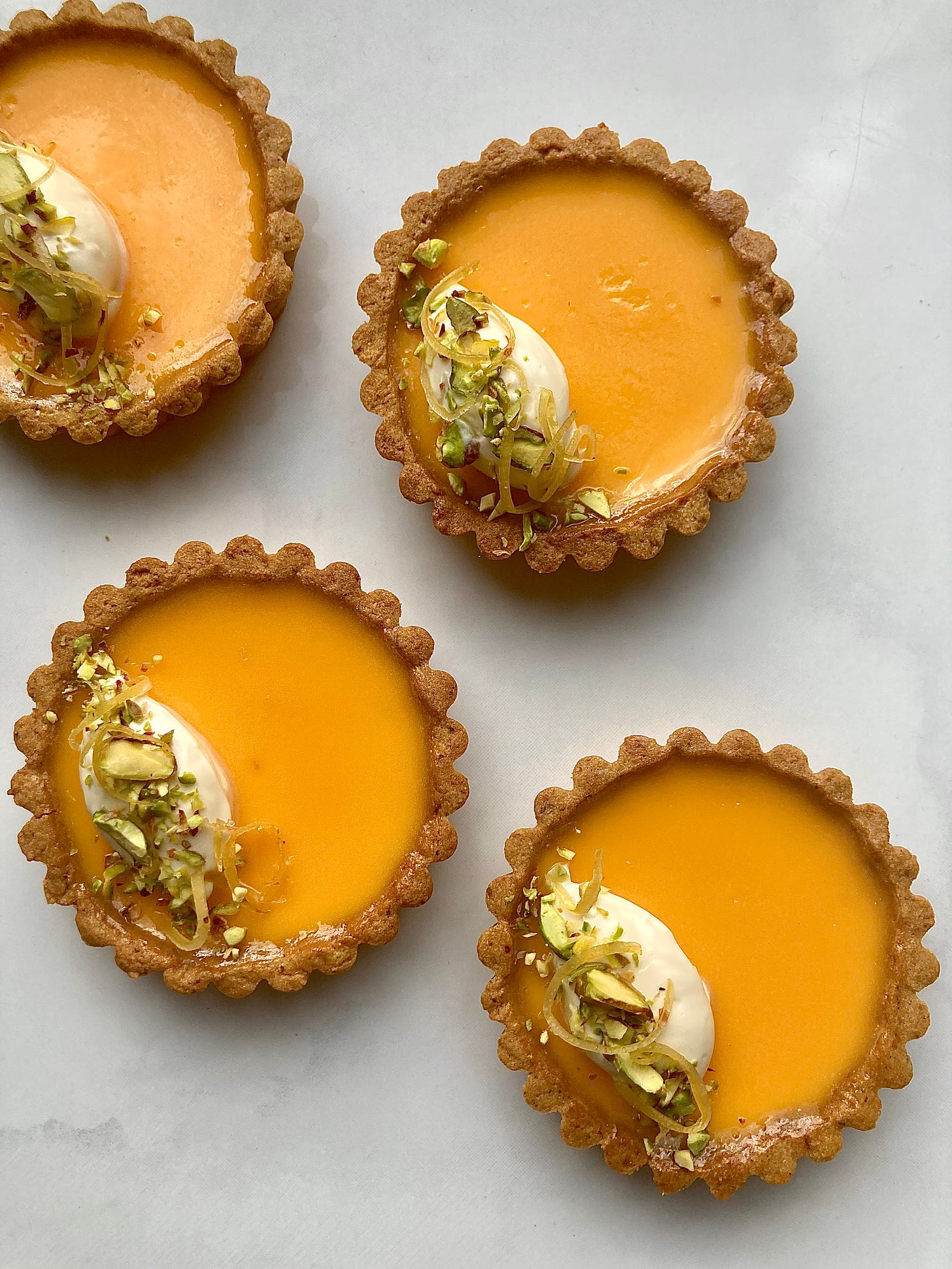
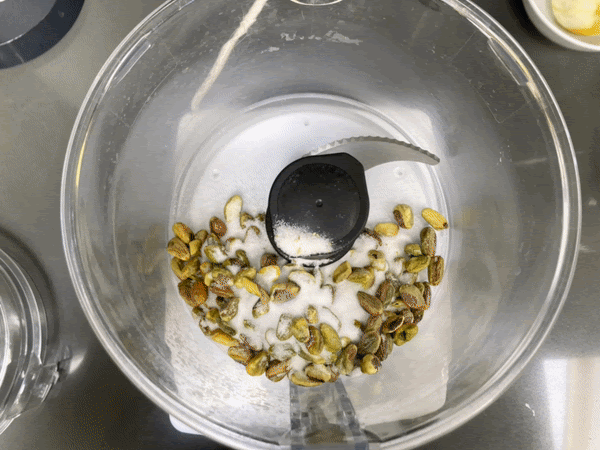
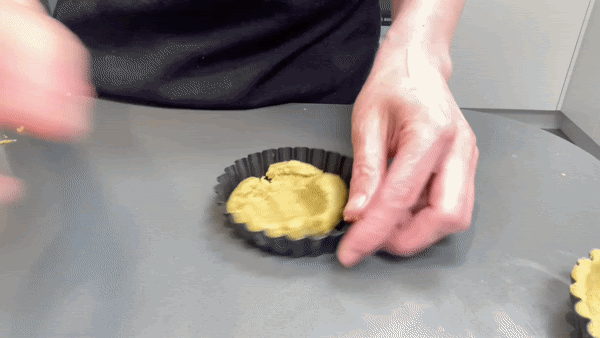
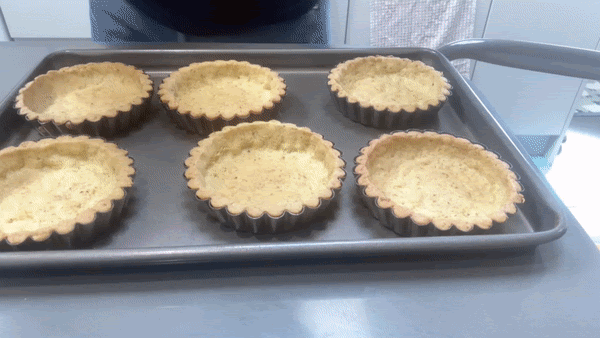
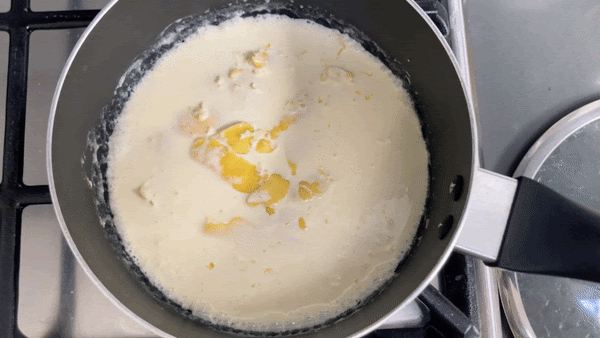
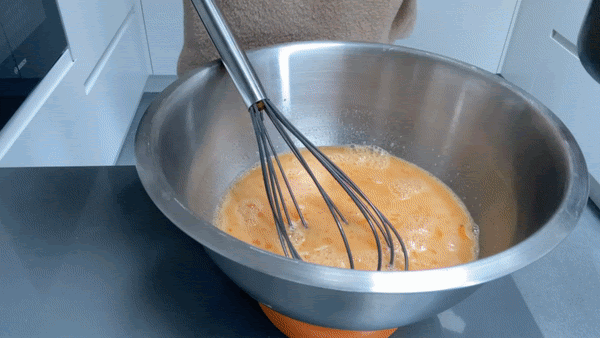
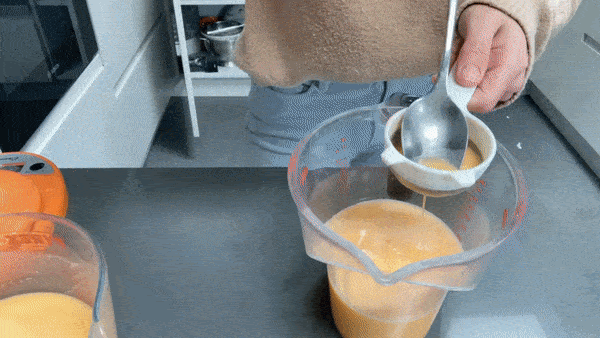
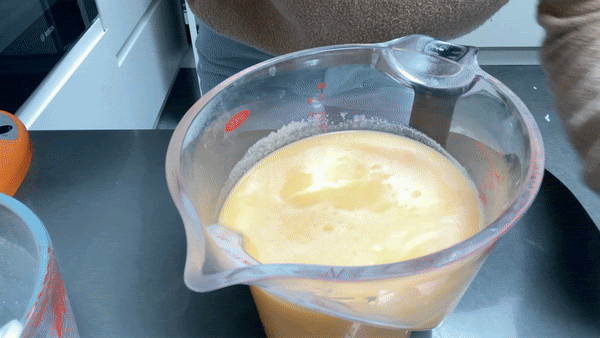
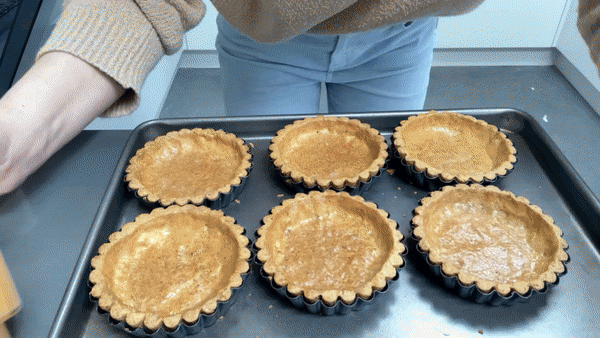
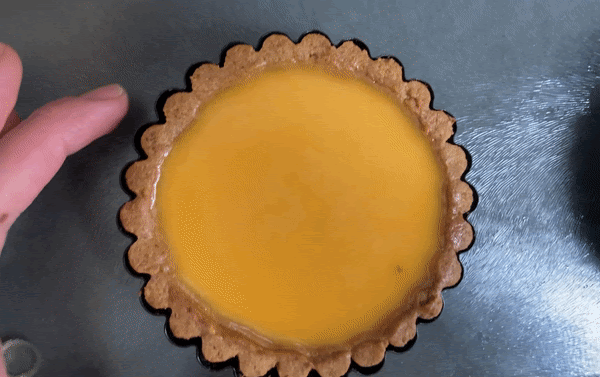
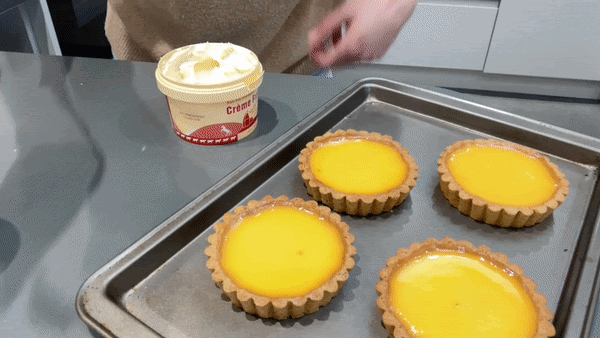
I, too, went down the baked lemon tart rabbit hole a few years ago. Happy days!
Interestingly, Heston made a <a href=https://www.theguardian.com/lifeandstyle/2003/mar/01/foodanddrink.shopping1>much sharper version</a> in the early days of The Fat Duck, using less sugar, egg, and cream, and twice as much juice as his later one. Unfortunately, I can’t remember what I thought of it at the time. In the end I seem to have settled on the version by Roger Pizey (ex Marco/Gavroche) which also has more lemon and less sugar than the Roux. (If you’re curious he goes with: 25% lemon juice, 18% double cream, 25% sugar, 32% egg.)
But I really must revisit that original Heston version at some point to see why I stepped over it. A couple of things that I did carry forward are to use whipping cream rather than double, and to warm the mix in a bain marie. Pouring a warm mix into a warm shell mitigates the problem of the filling separating into two layers when making a deep tart (3.5 cm).
I’ve only just found your feed so I’m looking forward to browsing the archive. Thanks.
Can’t wait to make these! For the pastry after combining the nuts with the sugar, do you just add everything else in?